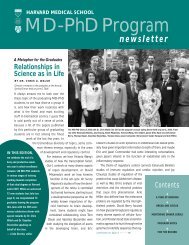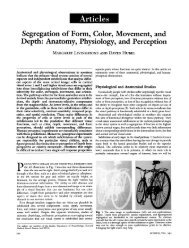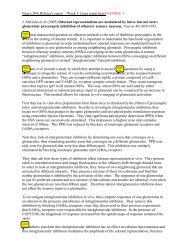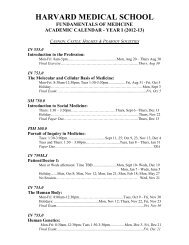The superior temporal sulcus (STS) of the macaque
The superior temporal sulcus (STS) of the macaque
The superior temporal sulcus (STS) of the macaque
You also want an ePaper? Increase the reach of your titles
YUMPU automatically turns print PDFs into web optimized ePapers that Google loves.
Figure 5 shows a horizontal section <strong>of</strong> <strong>the</strong> <strong>STS</strong> through bothMT and MST from <strong>the</strong> right hemisphere <strong>of</strong> <strong>the</strong> same monkey.Panels A and B show <strong>the</strong> distributions <strong>of</strong> 14 C and 3 H label,respectively, and panel C is <strong>the</strong> difference image. Consistentwith <strong>the</strong> flattened sections, <strong>the</strong> roughly columnar pattern in allthree <strong>of</strong> <strong>the</strong>se images is much more evident on <strong>the</strong> floor andposterior bank <strong>of</strong> <strong>the</strong> <strong>sulcus</strong>. <strong>The</strong> difference image shows nosigns <strong>of</strong> columnar interdigitation extending onto <strong>the</strong> anteriorbank.Figure 2. Calibration function for local phase algorithm. This graph shows <strong>the</strong> output <strong>of</strong>our local phase algorithm as a function <strong>of</strong> <strong>the</strong> phase difference between input images.<strong>The</strong> data for this figure were obtained by running simulations using two-dimensionalsine wave gratings <strong>of</strong> various, known phase <strong>of</strong>fsets. Because <strong>the</strong> phase differencewas constant over each input pair, <strong>the</strong> output was a relatively homogeneoustwo-dimensional array. <strong>The</strong> mean and standard deviation were calculated for each <strong>of</strong><strong>the</strong>se data sets and plotted in <strong>the</strong> figure. Note that <strong>the</strong> function has <strong>the</strong> desired behavior<strong>of</strong> being relatively linear, except at <strong>the</strong> extremes <strong>of</strong> phase. In order to better simulatereal-world conditions, 40% salt-and-pepper noise was added to <strong>the</strong> test images beforefiltering.ResultsBoth <strong>the</strong> 3 H and 14 C autoradiographs demonstrated a number <strong>of</strong>labeled columns in several diverse regions <strong>of</strong> cortex. We foundcolumnar labeling in auditory cortex, throughout regions <strong>of</strong> <strong>the</strong>inferior parietal <strong>sulcus</strong>, in areas V2 and VP, as well as in <strong>the</strong> <strong>STS</strong>.<strong>The</strong>se columns were oriented orthogonal to <strong>the</strong> surface <strong>of</strong> <strong>the</strong>cortex and extended through most or all cortical layers, withdensest labeling in <strong>the</strong> middle layers. <strong>The</strong>se columns weregenerally 0.2–0.5 mm in diameter, although <strong>the</strong> spacing between<strong>the</strong> columns varied more widely.Although columnar labeling was found in diverse areas <strong>of</strong>cortex, <strong>the</strong> patterns <strong>of</strong> 14 C and 3 H exposures superimposed in allregions examined, except for parts <strong>of</strong> <strong>the</strong> floor and posteriorbank <strong>of</strong> <strong>the</strong> <strong>STS</strong>. Within <strong>the</strong> <strong>STS</strong>, extensive regions <strong>of</strong>non-overlapping, columnar labeling were evident on <strong>the</strong> two sets<strong>of</strong> films (Figure 3). Panels A and B <strong>of</strong> Figure 3 show individualexposure patterns for <strong>the</strong> 14 C and 3 H isotopes respectively. PanelC, which is <strong>the</strong> difference <strong>of</strong> <strong>the</strong> patterns in panels A and B,clearly shows interdigitating columns indicative <strong>of</strong> a columnarorganization. <strong>The</strong>se images were obtained from <strong>macaque</strong> #1,where expansion and contraction patterns were compared.Panel E is <strong>the</strong> difference image in false-color, with greenrepresenting areas <strong>of</strong> 3 H label (expansion) and red 14 Clabel(contraction). Yellow regions <strong>of</strong> this image represent cells whichresponded to both motion patterns, while black image areascontained cells which responded to nei<strong>the</strong>r stimulus. Before <strong>the</strong>false color was applied, <strong>the</strong> gray-scale image <strong>of</strong> panel C was putthrough a difference-<strong>of</strong>-Gaussians filter (sd1 = 8 pixels; sd2 = 20pixels; kernel = 50 pixels) in order to smooth noise andemphasize <strong>the</strong> transitions between cortical columns.Figure 4 shows 3 H and 14 C autoradiographs <strong>of</strong> <strong>the</strong> corresponding<strong>STS</strong> anterior bank sections, along with <strong>the</strong>ir differenceimage. By referring to <strong>the</strong> scale bar for each image, it is apparentthat <strong>the</strong> labeled columns on <strong>the</strong> anterior bank were poorlydefined and large, and nearly superimpose for <strong>the</strong> two differentisotope maps.Phase RelationshipsIn Materials and Methods we described ano<strong>the</strong>r way <strong>of</strong>examining this relationship by calculating local relative phase.Figure 3F shows <strong>the</strong> result <strong>of</strong> applying this algorithm to <strong>the</strong>autoradiographs <strong>of</strong> <strong>the</strong> f loor and posterior bank <strong>of</strong> <strong>the</strong> <strong>STS</strong> from<strong>macaque</strong> #1 (expansion-versus-contraction). <strong>The</strong> blackenedareas <strong>of</strong> <strong>the</strong>se figures correspond to regions <strong>of</strong> tissue where both14 C and 3 H signals were weak and <strong>the</strong> phase <strong>of</strong>fset wasconsequently undefined. Although regions <strong>of</strong> maximum <strong>of</strong>fsetcorrespond to <strong>the</strong> area <strong>of</strong> interdigitation present in Figure 3C,this phase relationship is not constant within any extendedregion <strong>of</strong> cortex. Within <strong>the</strong> area <strong>of</strong> interdigitation exist localareas where <strong>the</strong> 14 C and 3 H images superimpose, as would beexpected for columns <strong>of</strong> neurons having motion preferencesorthogonal to those tested. Table 1 summarizes <strong>the</strong> averagephase <strong>of</strong>fsets for several cortical areas for one monkey. Forexample, in <strong>the</strong> area <strong>of</strong> cortex labeled as area MT in Figure 3, <strong>the</strong>average phase <strong>of</strong>fset was 93°. Within cortical areas V4t, V2/V3aand <strong>the</strong> anterior bank <strong>of</strong> <strong>the</strong> <strong>STS</strong>, <strong>the</strong> average phase differenceswere considerably less.<strong>The</strong> double label experiment was repeated with a secondmonkey, <strong>macaque</strong> #2. In this experiment, expansion androtation motion were compared (locally, motion was 90° apartra<strong>the</strong>r than 180°, as in <strong>macaque</strong> #1), phase differences wereconsiderably less pronounced, consistent with <strong>the</strong> decreaseddifference in local stimulus direction. <strong>The</strong> average local phasedifference in <strong>the</strong> region <strong>of</strong> interdigitation on <strong>the</strong> floor <strong>of</strong> <strong>the</strong><strong>superior</strong> <strong>temporal</strong> <strong>sulcus</strong> corresponding to areas MT and MSTwas only 58° in <strong>macaque</strong> #2, compared with 93 and 104° inareas MT and MST, respectively, in <strong>macaque</strong> #1 (Table 1).Because <strong>the</strong> pattern <strong>of</strong> interdigitation in <strong>macaque</strong> #2 was muchless distinct, <strong>the</strong> borders between anatomical areas weredifficult to determine, which is why we lumped toge<strong>the</strong>r phasedata for MT and MST in this monkey. As in <strong>the</strong> first monkey, <strong>the</strong>anterior bank for this <strong>macaque</strong> lacked differential labeling.We could not definitely assign <strong>the</strong> region <strong>of</strong> interdigitation on<strong>the</strong> floor and posterior bank <strong>of</strong> <strong>the</strong> <strong>STS</strong> to any single anatomicalarea, although <strong>the</strong> major area <strong>of</strong> interdigitation occupies aportion <strong>of</strong> <strong>the</strong> posterior bank <strong>of</strong> <strong>the</strong> <strong>STS</strong> previously identified asarea MT. We have superimposed tentative borders for thisoval-shaped cortical region over <strong>the</strong> 2-DG difference map inFigure 3D. Figure 6 (after figure 1 in Desimone and Ungerleider,1986) depicts <strong>the</strong> cortical areas within <strong>the</strong> <strong>STS</strong> mapped using acombination <strong>of</strong> single-unit recording and anatomical techniques.As labeled in Figure 3D, additional interdigitated regionsextending beyond tentative MT on <strong>the</strong> fundus <strong>of</strong> <strong>the</strong> <strong>STS</strong>correspond to areas previously identified as area MST. Based on<strong>the</strong>se previous studies, <strong>the</strong> oval patch <strong>of</strong> cortex in Figure 3devoid <strong>of</strong> label and adjacent to <strong>the</strong> anterior edge <strong>of</strong> <strong>the</strong>interdigitating pattern is probably <strong>the</strong> far peripheralrepresentation <strong>of</strong> MT (MTp) (Ungerleider and Desimone, 1986).Because <strong>the</strong> motion patterns that <strong>the</strong> monkeys viewed werelimited to <strong>the</strong> 20° <strong>of</strong> <strong>the</strong> visual field on ei<strong>the</strong>r side <strong>of</strong> <strong>the</strong> fixation752 Complex Motion Maps in <strong>the</strong> Superior Temporal Cortex • Geesaman et al.
Figure 3. Autoradiographs from flattened tissue sections and difference images <strong>of</strong> <strong>the</strong> posterior bank and floor <strong>of</strong> <strong>the</strong> <strong>STS</strong>. (A) 14 C label. (B) 3 H label. (C) Difference image. (D)Approximate anatomical borders superimposed over <strong>the</strong> image from C. This image was enhanced using a difference <strong>of</strong> gaussians filter. <strong>The</strong> periodicity produced within <strong>the</strong>non-interdigitating portions <strong>of</strong> D is an artifact <strong>of</strong> <strong>the</strong> filter. (E) False-color difference image. (F) False-color phase map <strong>of</strong> <strong>the</strong> <strong>STS</strong> floor and posterior bank from <strong>macaque</strong> #1. Differentiallabeling was seen both in area MT and in <strong>the</strong> two regions which extend onto <strong>the</strong> floor <strong>of</strong> <strong>the</strong> <strong>STS</strong>. Although <strong>the</strong>re was strong 3 H and 14 C labeling in neighboring regions such as V4t,<strong>the</strong> two patterns largely superimposed and <strong>the</strong> signal was absent in <strong>the</strong> difference image. <strong>The</strong> top border <strong>of</strong> this section is continuous with <strong>the</strong> border <strong>of</strong> <strong>the</strong> section shown in Figure4. See Figure 5 for a horizontal section through this same region <strong>of</strong> cortex, from <strong>the</strong> contralateral hemisphere. <strong>The</strong> phase map in F was constructed using <strong>the</strong> 14 C and 3 H images fromA and B. <strong>The</strong> region <strong>of</strong> maximum phase difference (red) corresponds well to regions <strong>of</strong> interdigitation seen on <strong>the</strong> difference map <strong>of</strong> C and D. However, <strong>the</strong> phase difference within<strong>the</strong> region <strong>of</strong> interdigitation varies considerably — <strong>the</strong>re are regions with MT proper where <strong>the</strong> labeling pattern is ‘in phase’, as would be expected for columns <strong>of</strong> neurons thatresponded similarly to <strong>the</strong>se specific motion stimuli. <strong>The</strong> color legend at <strong>the</strong> bottom <strong>of</strong> <strong>the</strong> figure was constructed based on <strong>the</strong> calibration curve <strong>of</strong> Figure 2. In this color scheme,violet represents a phase difference <strong>of</strong> 0° and red 180°. All images are to <strong>the</strong> same scale; <strong>the</strong> images in frames E and F are smaller because image edges were not zero-paddedbefore convolution.Cerebral Cortex Dec 1997, V 7 N 8 753
Figure 4. Autoradiographs from flattened tissue sections and difference images <strong>of</strong> <strong>the</strong>anterior bank <strong>of</strong> <strong>the</strong> <strong>STS</strong>. (A) 14 C label. (B) 3 H label. (C) Difference image. Note that <strong>the</strong>two labels nearly superimpose (in phase). <strong>The</strong> scale is <strong>the</strong> same as in Figure 3. <strong>The</strong>tissue from Figures 3 and 4 directly adjoin and were separated while preparing <strong>the</strong>sections.point, regions <strong>of</strong> cortex containing cells with receptive fieldsin <strong>the</strong> far periphery should be unlabeled. <strong>The</strong> two flankingregions <strong>of</strong> interdigitation have tentatively been assignedMSTd and MSTl, consistent with <strong>the</strong> Desimone and Ungerleidermap. This assignment is also consistent with boundariesbetween visual areas within <strong>the</strong> <strong>STS</strong> defined by labeling corticalFigure 5. Cross-sections <strong>of</strong> <strong>the</strong> <strong>STS</strong>, including areas MT and MST. Autoradiographscome from <strong>the</strong> unflattened (right) hemisphere <strong>of</strong> <strong>macaque</strong> #1. (A) 14 C label. (B) 3 Hlabel. (C) Difference image. <strong>The</strong> posterior bank is towards <strong>the</strong> top <strong>of</strong> each panel. <strong>The</strong>cortex surface is towards <strong>the</strong> left. Note on <strong>the</strong> difference image that <strong>the</strong> region <strong>of</strong>interdigitation ends just before <strong>the</strong> anterior bank. This is consistent with <strong>the</strong> flattenedsections <strong>of</strong> Figures 3 and 4. C shows <strong>the</strong> approximate location <strong>of</strong> <strong>the</strong> cut that separated<strong>the</strong> tissue from Figures 3 and 4.regions corresponding to <strong>the</strong> vertical and horizontal meridia.This was done using <strong>the</strong> same double-label 2-DG methodologydescribed here, but in <strong>the</strong> anes<strong>the</strong>tized <strong>macaque</strong> (Tootell andBorn, 1990).754 Complex Motion Maps in <strong>the</strong> Superior Temporal Cortex • Geesaman et al.
Table 1. Average phase differences between 3 H and 14 C autoradiographs from different visualareasCortical area Phase difference (°)MT 93MST 104<strong>STS</strong> ant. bank 56V4t 48V2/V3 26<strong>STS</strong> floor (<strong>macaque</strong> 92-1) 58All values are for <strong>macaque</strong> #1 (expansion-versus-contraction) except <strong>the</strong> last entry(expansion-versus-rotation in <strong>macaque</strong> #2). Values were calculated according to <strong>the</strong> local phasealgorithm described in <strong>the</strong> text.Figure 6. Map <strong>of</strong> <strong>the</strong> <strong>STS</strong> showing multiple cortical areas, taken from Desimone andUngerleider (1986), constructed using a combination <strong>of</strong> single unit recording and myelinstaining.DiscussionWe have shown evidence that neurons tuned to motion areorganized into distinct cortical columns within <strong>the</strong> <strong>STS</strong> <strong>of</strong> <strong>the</strong><strong>macaque</strong> monkey.Tuning SpecificityAreas <strong>of</strong> interdigitation in <strong>the</strong> difference image correspond toregions <strong>of</strong> cortex where anatomically distinct populations <strong>of</strong>neurons responded differently to <strong>the</strong> two stimulus patterns.Such a pattern does not necessarily ref lect a functionalorganization with respect to complex motion per se. Forexample, although area MT has not been shown to possessneurons selective for <strong>the</strong>se patterns, differential labelingoccurred in this study because <strong>of</strong> <strong>the</strong>se cells’ specificity for locallinear motion. This is because <strong>the</strong> receptive fields in MT cells aresmall compared with <strong>the</strong> 40° diameter stimulus patterns used inthis study, so that <strong>the</strong> portion <strong>of</strong> <strong>the</strong> stimulus viewed by a singleMT cell contained approximately linear motion (Figure 7). Thusin <strong>the</strong> experiment where we compared expansion withcontraction, an MT neuron whose receptive field was locatedabove <strong>the</strong> fixation point would ‘see’ essentially linear upwardmotion during <strong>the</strong> first condition and linear downward motionduring <strong>the</strong> second. This is particularly true for those neuronswith receptive fields near <strong>the</strong> periphery <strong>of</strong> <strong>the</strong> stimulus. As aresult, <strong>the</strong> interdigitation seen within area MT most likelyref lects <strong>the</strong> previously proposed organization with respect tolinear motion (Albright et al., 1984).This caveat might also apply to <strong>the</strong> interdigitating columnsseen in area MST; however, given <strong>the</strong> large receptive field sizes <strong>of</strong>neurons in this area and previous demonstrations that neuronshere are indeed tuned for complex motion patterns, we feel it ismuch less likely. Instead, we interpret <strong>the</strong> patterns found on <strong>the</strong>f loor <strong>of</strong> <strong>the</strong> <strong>STS</strong> to be <strong>the</strong> first anatomical evidence for acolumnar organization <strong>of</strong> neurons selective for complex motionpatterns.Figure 7 makes <strong>the</strong> additional point that <strong>the</strong> pattern <strong>of</strong> labelingFigure 7. Complex motion patterns and linear receptive fields with <strong>the</strong> samedirectional tuning but different retinotopy. An MT neuron tuned for linear motion with asmall receptive field will respond to <strong>the</strong> directional motion components <strong>of</strong> complexmotion patterns. Although tuning to linear motion is <strong>the</strong> same for <strong>the</strong> two cells, tuningfor complex motion patterns depends on <strong>the</strong> placement <strong>of</strong> <strong>the</strong> stimulus. As explained in<strong>the</strong> text, DG labeling patterns depend on receptive field size, tuning specificity andlocation <strong>of</strong> <strong>the</strong> receptive field.is influenced both by <strong>the</strong> selectivity <strong>of</strong> <strong>the</strong> cell and <strong>the</strong> location<strong>of</strong> <strong>the</strong> cell’s receptive field with respect to <strong>the</strong> stimulus. In thisschematic model, both cells are tuned for upward motion. <strong>The</strong>cell with its receptive field above <strong>the</strong> fixation point respondswell to <strong>the</strong> expansion pattern but poorly to <strong>the</strong> contraction. <strong>The</strong>cell below <strong>the</strong> fixation pattern has <strong>the</strong> opposite response,although <strong>the</strong> two cells share <strong>the</strong> same tuning specificity.<strong>The</strong>refore, <strong>the</strong> labeling patterns we obtained in MT weredetermined both by tuning selectivity and retinotopy.Direction ColumnsDirectly relevant to this study are reports <strong>of</strong> directionalselectivity in <strong>the</strong> <strong>superior</strong> <strong>temporal</strong> <strong>sulcus</strong>. Using single-unitmapping <strong>of</strong> this region, Albright et al. (1984) found a clustering<strong>of</strong> units with similar response selectivity in area MT. Similar to<strong>the</strong> arrangement in striate cortex for orientation, <strong>the</strong>y found that,moving tangential to <strong>the</strong> cortical surface, direction preferencechanges gradually, with periodic 180° reversals in <strong>the</strong> preferreddirection. Based on <strong>the</strong>se data, <strong>the</strong>y suggested that cells withsimilar directional tuning are organized into con- tinuous slabs <strong>of</strong>cortex aligned normal to <strong>the</strong> pial surface.Our study generally supports Albright’s proposed functionalorganization for MT. Because our stimuli are large comparedwith <strong>the</strong> size <strong>of</strong> an MT neuron’s receptive field, during labeling<strong>the</strong>se cells viewed essentially linear motion through <strong>the</strong> aperture<strong>of</strong> <strong>the</strong>ir receptive fields. <strong>The</strong> component motion vectors wereessentially perpendicular to one ano<strong>the</strong>r for <strong>the</strong> case <strong>of</strong>expansion and rotation and were oriented 180° apart forexpansion and contraction. Our results are <strong>the</strong>refore consistentwith those obtained in <strong>the</strong> anes<strong>the</strong>tized <strong>macaque</strong> by Tootell andBorn (1991) using translational motion and double-label DGtechniques. <strong>The</strong>y found that an interdigitating mosaic <strong>of</strong> columnsin area MT was best obtained using motion patterns <strong>of</strong> oppositedirectionality.With <strong>the</strong> stimulus patterns used in this study, <strong>the</strong> calculatedphase difference within MT/MST was always much less than180°. Failure to achieve perfect interdigitation is explained byFigure 3E, which shows areas within MT/MST that did notrespond to ei<strong>the</strong>r pattern. Some <strong>of</strong> <strong>the</strong>se unlabeled subregionspotentially represent interbands within <strong>the</strong> band/interbandarchitecture reported in area MT (Born and Tootell, 1992). MTinterbands respond well to small motion patterns but poorly tolarge stimuli, such as those used in <strong>the</strong> current study. In support<strong>of</strong> this explanation, when our phase algorithm was applied to2-DG images <strong>of</strong> area MT from a unpublished study which usedCerebral Cortex Dec 1997, V 7 N 8 755
small, linear motion patterns, <strong>the</strong> average phase differenceapproached 180°.Significance <strong>of</strong> Cortical Columns<strong>The</strong> images obtained in this study lend fur<strong>the</strong>r support to <strong>the</strong>hypo<strong>the</strong>sis that mammalian cortex is organized into anatomicalcolumns that are composed <strong>of</strong> functionally discrete subunits(for a review see Tootell et al., 1993). As is typical (butunder-reported in DG studies), we saw evidence <strong>of</strong> columnarorganization throughout diverse regions <strong>of</strong> <strong>the</strong> brain, includingauditory cortex, somatosensory cortex and visual cortex,although we found a systematic representation <strong>of</strong> motion patternonly on <strong>the</strong> posterior bank and floor <strong>of</strong> <strong>the</strong> <strong>superior</strong> <strong>temporal</strong><strong>sulcus</strong>.Organizing cortex into functional columns decreases <strong>the</strong>wiring complexity <strong>of</strong> establishing connections betweendifferent neurons, because neurons with similar responsepr<strong>of</strong>iles and receptive field locations make similar types <strong>of</strong>connections (Cowey, 1979; Nelson and Bower, 1990; Mitchison,1992). Along <strong>the</strong>se lines, <strong>the</strong>se authors have argued that dividing<strong>the</strong> brain up into different anatomic regions and fur<strong>the</strong>rbreaking up <strong>the</strong>se regions into discrete functional subunits(Mitchison, 1992) minimizes wiring volume. Clustering units <strong>of</strong>similar specificity toge<strong>the</strong>r also facilitates <strong>the</strong> formation <strong>of</strong> localcircuits via <strong>the</strong> dendritic processes <strong>of</strong> projection neurons and <strong>the</strong>processing provided by local interneurons (Tootell et al., 1993).Shadlen and Newsome (1994) have argued that <strong>the</strong> intrinsicnoisiness <strong>of</strong> a single neuron’s rate code requires redundancy tosmooth out this variability. Clustering neurons <strong>of</strong> similarspecificity into cortical columns is an efficient way <strong>of</strong>introducing this redundancy without fur<strong>the</strong>r increasing <strong>the</strong>complexity <strong>of</strong> <strong>the</strong> wiring.<strong>The</strong> apparent columnar organization for complex patterns <strong>of</strong>motion within area MSTd has interesting implications for <strong>the</strong>mapping <strong>of</strong> space using optical f low motions. Bradley et al.(1996) have recently shown that area MSTd neurons adjust <strong>the</strong>irfocus tuning to compensate for eye movements, providing strongevidence that MSTd activity codes <strong>the</strong> heading for navigation,regardless <strong>of</strong> whe<strong>the</strong>r <strong>the</strong> eyes are stationary or moving. Britten(1996) has found that microstimulation <strong>of</strong> expansion columnswithin MSTd can bias a monkey’s perceived heading direction.<strong>The</strong>se experiments suggest that <strong>the</strong> complex-motion columnswithin area MSTd may comprise a functional map <strong>of</strong> spacederived from optical flow information.Final Comments<strong>The</strong>re are several advantages <strong>of</strong> combining two activity labels inawake-behaving monkeys. First, <strong>the</strong>re is always <strong>the</strong> concern that<strong>the</strong> response pr<strong>of</strong>iles <strong>of</strong> cells may change under anes<strong>the</strong>sia,making generalizations to <strong>the</strong> awake animal tenuous.Specifically, cortical activity has been shown to be suppressedunder <strong>the</strong> inf luence <strong>of</strong> anes<strong>the</strong>sia and <strong>the</strong> metabolic ratethroughout <strong>the</strong> gray matter becomes more uniform (Sokol<strong>of</strong>f,1977; Sokol<strong>of</strong>f et al., 1977). Ano<strong>the</strong>r advance <strong>of</strong> this study was<strong>the</strong> more perfect separation <strong>of</strong> <strong>the</strong> two 2-DG labeling patternusing techniques described in <strong>the</strong> Materials and Methodssection.In conclusion, using <strong>the</strong> 2-DG double labeling technique wehave demonstrated <strong>the</strong> presence <strong>of</strong> a columnar organization inareas <strong>of</strong> cortex sensitive to complex motion patterns such asexpansion, rotation and contraction. We were able to visualizethis organization with isotope maps labeling cells <strong>of</strong> knownspecificity. This interdigitation was more pronounced forexpansion/contraction than expansion/rotation, suggesting thatunits driven by expansion and contraction patterns aremaximally separated across <strong>the</strong> surface <strong>of</strong> <strong>the</strong> cortex, as onewould expect from a 360° mapping <strong>of</strong> local or global direction.We have argued, based on retinotopy and <strong>the</strong> pattern <strong>of</strong> periodiclabeling evident on difference images, that <strong>the</strong> area <strong>of</strong>interdigitation partially overlaps both regions MT and MST.Notes<strong>The</strong> authors would like to thank Gail Robertson for excellent technicalassistance and Ning Qian for a discussion <strong>of</strong> <strong>the</strong> local phase algorithm.This project was support by NIH grants RO1 EY07492 (R.A.A.), RO1EY11379 (R.T.B.) and RO1 EY07980 (R.B.H.T.), and <strong>the</strong> Human FrontiersScience Program (R.A.A. and R.B.H.T.).Address correspondence to: Roger B. H. Tootell, MGH NMR Center,149 13th St., Charlestown, MA 02129, USA.ReferencesAlbright TD (1984) Direction and orientation selectivity <strong>of</strong> neurons invisual area MT <strong>of</strong> <strong>the</strong> <strong>macaque</strong>. J Neurophysiol 52:1106–1130.Albright TD (1993) Cortical processing <strong>of</strong> visual motion [Review]. RevOculomot Res 5177–5201.Albright TD, Desimone R, Gross CG (1984) Columnar organization <strong>of</strong>directionally selective cells in visual area MT <strong>of</strong> <strong>the</strong> <strong>macaque</strong>. JNeurophysiol 51:16–31.Albus K (1979) 14 C-Deoxyglucose mapping <strong>of</strong> orientation subunits in <strong>the</strong>cats visual cortical areas. Exp Brain Res 37:609–613.Berman NE, Wilkes ME, Payne BR (1987) Organization <strong>of</strong> orientation anddirection selectivity in areas 17 and 18 <strong>of</strong> cat cerebral cortex. JNeurophysiol 58:676–699.Blasdel GG, Salama G (1986) Voltage-sensitive dyes reveal a modularorganization in monkey striate cortex. Nature 321:579–585.Born RT, Tootell RBH (1989) Spatial frequency tuning and surroundinhibition <strong>of</strong> single units in <strong>macaque</strong> supragranular striate cortex.Ophthalmol Vis Sci (Suppl) 30:111.Born RT, Tootell RBH (1992) Segregation <strong>of</strong> global and local motionprocessing in primate middle <strong>temporal</strong> visual area. Nature357:497–499.Bradley DC, Maxwell M, Andersen RA, Banks MS, Shenoy KV (1996)Mechanisms <strong>of</strong> heading perception in primate visual cortex. Science273:1544–1547.Britten KH (1996) Microstimulation <strong>of</strong> extrastriate area MST influencesheading judgements in monkeys. Soc Neurosci Abstr 22:1692.Desimone R, Ungerleider LG (1986) Multiple visual areas in <strong>the</strong> caudal<strong>superior</strong> <strong>temporal</strong> <strong>sulcus</strong> <strong>of</strong> <strong>the</strong> <strong>macaque</strong>. J Comp Neurol248:164–189.Duffy CJ, Wurtz RH (1991) Sensitivity <strong>of</strong> MST neurons to optic flowstimuli. I. A continuum <strong>of</strong> response selectivity to large-field stimuli. JNeurophysiol 65:1329–1345.Friedman HR, Bruce CJ, Goldman-Rakic PS (1987) A sequentialdouble-label14 C- and 3 H-2-DG technique: validation by doubledissociation<strong>of</strong> functional states. Exp Brain Res 66:543–554.Friedman HR, Bruce CJ, Goldman-Rakic PS (1989) Resolution <strong>of</strong>metabolic columns by a double-label 2-DG technique: interdigitationand coincidence in visual cortical areas <strong>of</strong> <strong>the</strong> same monkey. JNeurosci 9:4111–4121.Fujita I, Tanaka K, Ito M, Cheng, K (1992) Columns for visual features <strong>of</strong>objects in monkey infero<strong>temporal</strong> cortex. Nature 360:343–346.Geesaman BJ, Andersen RA (1996) <strong>The</strong> analysis <strong>of</strong> complex motionpatterns by form/cue invariant MSTd neurons. J Neurosci16:4716–4732.Graziano MS, Andersen RA, Snowden, RJ (1994) Tuning <strong>of</strong> MST neuronsto spiral motions. J Neurosci 14:54–67.Hubel DH, Livingstone MS (1987) Segregation <strong>of</strong> form, color, andstereopsis in primate area 18. J Neurosci 7:3378–3415.Hubel DH, Wiesel TN (1962) Receptive fields, binocular interaction andfunctional architecture in <strong>the</strong> cat’s visual cortex. J Physiol160:106–154.Hubel DH, Wiesel TN (1968) Receptive fields and functional architecture<strong>of</strong> monkey striate cortex. J Physiol 195:215–243.Hubel DH, Wiesel TN, Stryker MP (1977) Orientation columns in756 Complex Motion Maps in <strong>the</strong> Superior Temporal Cortex • Geesaman et al.
<strong>macaque</strong> monkey visual cortex demonstrated by <strong>the</strong> 2-deoxyglucoseautoradiographic technique. Nature 269:328–330.Judge SJ, Richmond BJ, Chu FC (1980) Implantation <strong>of</strong> magnetic searchcoils for measurment <strong>of</strong> eye position: an improved method. Vision Res20:535–538.Juhler M, Diemer NH (1987) A method for 14 C and 3 H double-labelautoradiography. J Cereb Blood Flow Metab 7:572–577.Kennedy C, Des Rosiers M, Jehle JW, Reivich M, Sharp F, Sokol<strong>of</strong>f L (1975)Mapping <strong>of</strong> functional neural pathways by autoradiographic survey <strong>of</strong>local metabolic rate with 14 C deoxyglucose. Science 187:850–853.Lagae L, Maes H, Raiguel S, Xiao DK, Orban GA (1994) Responses <strong>of</strong><strong>macaque</strong> <strong>STS</strong> neurons to optic flow components: a comparison <strong>of</strong>areas MT and MST. J Neurophys 71:1597–1626.Livingstone MS, Hubel DH (1981) Effects <strong>of</strong> sleep and arousal on <strong>the</strong>processing <strong>of</strong> visual information in <strong>the</strong> cat. Nature 291:554–561.Livingstone MS, Hubel DH (1984) Anatomy and physiology <strong>of</strong> a colorsystem in <strong>the</strong> primate visual cortex. J Neurosci 4:309–356.Malonek D, Tootell RB, Grinvald A (1994) Optical imaging reveals <strong>the</strong>functional architecture <strong>of</strong> neurons processing shape and motion inowl monkey area MT. Proc Roy Soc Lond B 258:109–119.Maunsell JH, Newsome WT (1987) Visual processing in monkeyextrastriate cortex. Ann Rev Neurosci 10:363–401.Maunsell J, van Essen DC (1983) Functional properties <strong>of</strong> neurons inmiddle <strong>temporal</strong> visual area <strong>of</strong> <strong>the</strong> <strong>macaque</strong> monkey. I. Selectivityfor stimulus direction, speed, and orientation. J Neurophysiol49:1127–1147.Mitchison G (1992) Axonal trees and cortical architecture. TrendsNeurosci 15:122–126.Mountcastle VB (1957) Modality and topographic properties <strong>of</strong> singleneurons <strong>of</strong> cat’s somatic sensory cortex. J Neurophysiol 20:408–434.Payne BR, Berman N, Murphy EH (1981) Organization <strong>of</strong> directionpreferences in cat visual cortex. Brain Res 211:445–450.Raiguel L, Orban G (1993) Speed and directional selectivity <strong>of</strong> <strong>macaque</strong>middle <strong>temporal</strong> neurons. J Neurophysiol 69:19–39.Redies C, Diksic M, Evans AC, Gjedde A, Yamamoto YL (1987)Double-label autoradiographic deoxyglucose method for sequentialmeasurement <strong>of</strong> regional cerebral glucose utilization. Neuroscience22:601–619.Robinson DA (1963) A method <strong>of</strong> measuring eye movement using a scleralsearch coil in a magnetic field. IEEE Trans Biomed Engng 10:137–145.Sakata H, Shibutani H, Ito Y, Tsurugai K (1986) Parietal cortical neuronsresponding to rotatary movement <strong>of</strong> visual stimulus in space. ExpBrain Res 61:658–663.Sanger TD (1988) Stereo disparity computation using Gabor filters. BiolCybern 59:405–418.Shadlen, MN, Newsome WT (1994) Noise, neural codes and corticalorganization. Curr Opin Neurobiol 4:569–579.Sokol<strong>of</strong>f L (1977) Relation between physiological function and energymetabolism in <strong>the</strong> central nervous system [Review]. J Neurochem29:13–26.Sokol<strong>of</strong>f L, Reivich M, Kennedy C, Des Rosiers MH, Patlak CS, PettigrewKD, Sakurada O, Shinohara M (1977) <strong>The</strong> [ 14 C]deoxyglucose methodfor <strong>the</strong> measurement <strong>of</strong> local cerebral glucose utilization: <strong>the</strong>ory,procedure, and normal values in <strong>the</strong> conscious and anes<strong>the</strong>tizedalbino rat. J Neurochem 28:897–916.Swindale NV, Matsubara JA, Cynader MS (1987) Surface organization <strong>of</strong>orientation and direction selectivity in cat area 18. J Neurosci7:1414–1427.Tanaka K, Hikosaka K, Saito H, Yukie M, Fukada Y, Iwai E (1986) Analysis<strong>of</strong> local and wide-field movements in <strong>the</strong> <strong>superior</strong> <strong>temporal</strong> visualareas <strong>of</strong> <strong>the</strong> <strong>macaque</strong> monkey. J Neurosci 6:134–144.Tolhurst DJ, Dean AF, Thompson ID (1981) Preferred direction <strong>of</strong>movement as an element in <strong>the</strong> organization <strong>of</strong> cat visual cortex. ExpBrain Res 44:340–342.Tootell RBH, Born RT (1990) Patches and direction columns in primatearea MT. Invest Ophthalmol (ARVO Abstr) 31:238.Tootell RBH, Born RT (1991) Architecture <strong>of</strong> primate area MT. SocNeurosci Abstr 17:524.Tootell RBH, Silverman MS (1985) Two methods for flat-mountingcortical tissue. J Neurosci Methods 15:177–190.Tootell RBH, Silverman MS, Switkes E, DeValois RL (1982) Deoxyglucoseanalysis <strong>of</strong> retinotopic organization in primate striate cortex. Science218:902–904.Tootell RBH, Born RT, Hamilton SL (1988a) Studies <strong>of</strong> primate visualcortex using double-label 2-dg and color autoradiograph. Soc NeurosciAbstr 14:897.Tootell RBH, Hamilton SL, Silverman MS, Switkes E (1988b) Functionalanatomy <strong>of</strong> <strong>macaque</strong> striate cortex. I. Ocular dominance, binocularinteractions, and baseline conditions. J Neurosci 8:1500–1530.Tootell RBH, Silverman MS, Hamilton SL, Switkes E, De Valois RL (1988c)Functional anatomy <strong>of</strong> <strong>macaque</strong> striate cortex. V. Spatial frequency. JNeurosci 8:1610–1624.Tootell RBH, Born RT, Ash-Bernal R (1993) Columnar organization invisual cortex in non-human primates and man. In: Functionalorganization <strong>of</strong> <strong>the</strong> human visual system. Oxford: Pergamon Press.Ungerleider LG, Desimone R (1986) Projections to <strong>the</strong> <strong>superior</strong> <strong>temporal</strong><strong>sulcus</strong> from <strong>the</strong> central and peripheral field representations <strong>of</strong> V1 andV2. J Comp Neurol 248:147–163.Cerebral Cortex Dec 1997, V 7 N 8 757
















